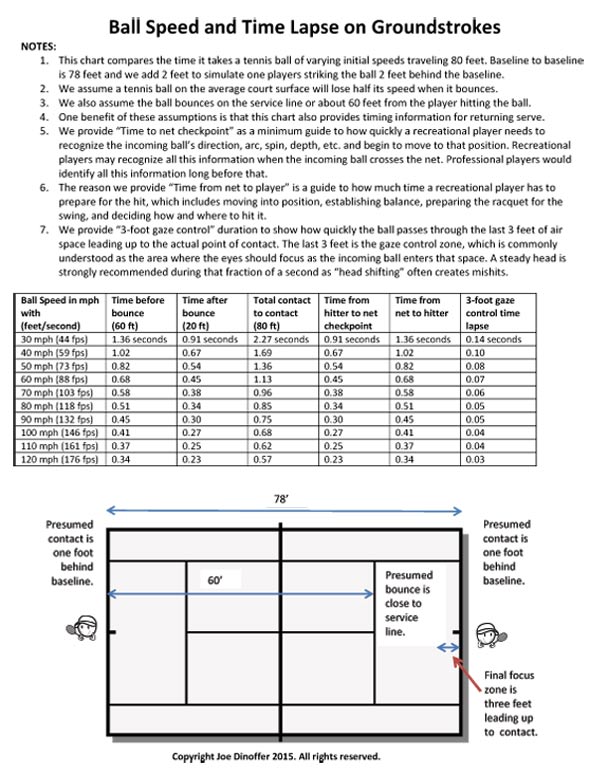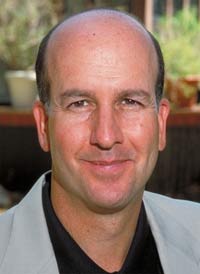|
TennisOne Lessons Understanding Timing for Better Tennis Tennis can be a game of inches. More importantly, it is a game of fractions of a second! Joe Dinoffer In comedy, it is said that “Timing is everything.” Tennis is no different, except at the end of a well-timed winning shot, only one player is laughing. It is also said that tennis can be a game of inches. But far more important is that tennis is a game of fractions of a second! Yes, things happen fast on a tennis court.
The chart that accompanies this article will take more than a few seconds to absorb, but it is well worth the effort. It is humbling to consider how fast the human eye and brain can “read, react, and respond” to a tennis ball in motion at various speeds. I have stood before serves above 120 mph and can testify that while it is challenging to be able to return serves at those speeds, with practice it can become less intimidating. In my younger playing days, I competed in a few (very) small ATP events in Europe. In that era hardly anybody regularly served at speeds above 120 mph. Today, players return serves in the 130-140 mph range and sometimes even faster than that — it is nearly superhuman, yet they do it all the time.
While these nearly “supersonic” ball speeds at the pro level are now commonplace, the pros are obviously challenged by them when you factor in the varieties of spin, speed, placement, and disguise. For an intermediate level recreational tennis player, 120+ mph serves could be life threatening, and nearly impossible to return. For those recreational players, returning incoming serves in the 50-90 mph range are more commonplace. And, at that playing level, groundstrokes are slower, mostly in the 30-50 mph range. I share these reference points, so you can review the chart more individually based on your own playing level.
The purpose of this chart is to provide a reference for different ball speeds and how little time we have to “read, react and respond” to incoming balls. But, here’s the real question: How can we use this information to improve our own games? Here is the Answer: Try this simple auditory biofeedback exercise to speed up your own ball recognition to improve your preparation and playing skills. Here’s how it works. Primary Call-out Drill You and a partner rally, while a third person stands by the net. When your partner’s shot crosses the imaginary line above the net, the third person calls out “net” to indicate the ball crossed into your half of the court. Your job is to call out “forehand” or “backhand” as soon as you identify whether the incoming ball is going towards your forehand or backhand groundstroke. Your goal is to correctly call out “forehand” or “backhand” before you hear the word “net.” If you find yourself slow and late, take a risk and call it out earlier. You may make some mistakes, but by allowing yourself to miss some, you will start speeding up your ball recognition skills.
Some of you will be very successful at this exercise while others will be challenged. If you find it too easy, have the “call-out” move the trigger “call-out” incrementally closer to the opposite baseline. So, if the “net” is too easy, have that person call out “now” when the ball passes the halfway mark in the hitter’s service box. If that’s too easy, have them call out “now” when the ball passes the service line itself. If you can consistently read the ball before it passes the service line on the opposing side of the net and start your movement and racquet preparation for your response at the same time, you are playing fairly high level tennis. What Do the Pros See? Professional players scan the opposite side of the net to play detective on every shot possible. They look for clues to determine what next shot their opponent will throw at them. How to play “tennis detective” will be a discussion for another time, but for now here are some variations on this basic drill idea: Repeat everything as just explained, except change the hitting “call-out” to identify different ball path options that you can judge and identify. With each, just come up with a definition, such as saying that a short-bouncing ball (#3 below) is a shot that bounces inside the service line, and that a deep bouncing ball lands behind it.
The point is that the sooner we identify whether the incoming ball is coming to our forehand or backhand, short or deep, slow or fast, low or high, with topspin or backspin, the earlier we will prepare and the better we will play. Now take another look at the chart. Again, note that reaction time in tennis is measured in parts of a second. Not much time at all. Heck, if you blink at the wrong time, it can cause you to be late. At least in tennis (for all of us non-professional players) it’s all for fun and fitness. If you often get distracted driving a car, it doesn’t take long before you get in an accident. And, if you are a boxer, you can get knocked out! Let’s be thankful that tennis is a lot more forgiving. Your comments are welcome. Let us know what you think about Joe Dinoffer's article by emailing us here at TennisOne.
Joe Dinoffer is among 10 master professionals in both the USPTA and PTR. He was also awarded the USPTA National Industry Excellence Award as well as Texas Division Pro of the Year. He has written and produced 7 books and 22 DVDs and has appeared numerous times on the Tennis Channel. Joe is also the founder and President of Oncourt Offcourt, Ltd., a tennis company recognized as one of the most creative in the industry. See his work at www.OncourtOffcourt.com. |

 Joe Dinoffer
Joe Dinoffer